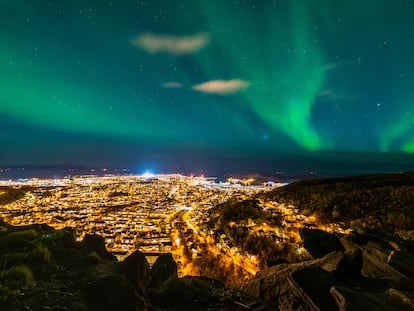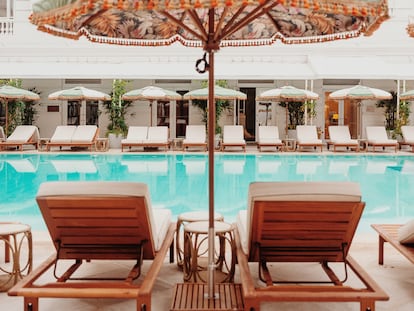Discover Panama: From the capital to the Canal to its Caribbean beaches and tropical jungles
The monuments, restaurants and hotels of the Old Town of Panama City, the colonial fortresses of San Lorenzo and Portobelo, excursions to learn about the Emberá ethnic group and a visit to the Panama Canal are the milestones of a complete route through the Latin American country
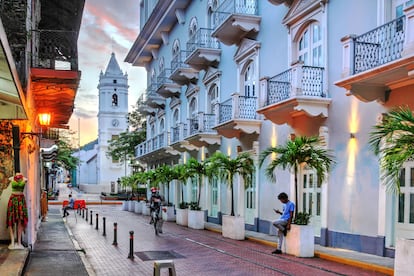
Panama — the youngest nation in Latin America — united Central and North America with South America, while connecting the Atlantic Ocean with the Pacific. It’s a small country of enormous contrasts, filled with diverse tourist attractions.
Like small floating corks in the immense bay, countless gigantic merchant ships wait their turn to change oceans in front of the Panama Canal. The capital, Panama City, outlines its imposing profile of skyscrapers against stormy clouds.
Ancient enclaves such as Casco Viejo — the Old Town of Panama — and Panamá Viejo are in the same capital, but they’re not the same as modern Panama City, much of which is crowded with skyscrapers. The capital is the Latin Manhattan, or the Hispanic Hong Kong — an important financial center and a modern, cosmopolitan and multiracial metropolis, with great cultural offerings.
One institution that stands out is the Biomuseum. Brightly-colored and containing Panama’s ecological history, it was designed by world-renowned architect Frank Gehry. Meanwhile the city’s leisure and gastronomy scenes are equally interesting and varied: it is possible to enjoy nature in the nearby Metropolitan National Park — hiking, bird-watching, or enjoying incomparable views of the city skyline — to restaurants offering the best international cuisine.
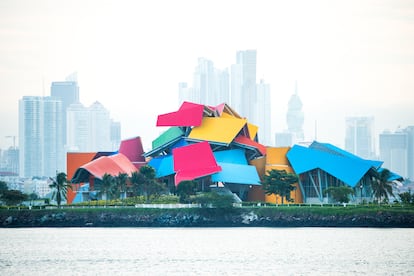
Panama Viejo — “Old Panama’ — is the colonial city that was built over Indigenous territory, before the pirate Henry Morgan destroyed it in 1671. Recognized as a UNESCO World Heritage Site since 1997, it’s designed in a reticular shape — oriented towards the four cardinal points — and has the classic Spanish plaza mayor or main square at its center.
About 20 minutes away by car, in the district of San Felipe, is Casco Viejo (“the Old Town”). Having suffered repeated fires over time, its current configuration dates back to the end of the 19th century. Efforts have been made to preserve and restore colonial, neoclassical and Art Deco buildings. Today, it’s very inviting for visitors, who can stroll through quiet cobbled streets during the daytime to enjoy the monuments, elegant restaurants and fine shops. In the night, however, it’s significantly noisier: several old mansions have been converted into nightclubs.
The Plaza Mayor, Plaza de la Independencia or (the most popular) Plaza Catedral have always been the epicenter of the Old Town. They’ve witnessed major national events, such as independence from Spain in 1821, or the separation from Colombia in 1903. Here, there are two emblematic buildings: Santa María La Antigua, which is a basilica with a notable baroque-colonial style, and the Central Hotel Panamá, the first luxury hotel that was ever built in the country. Over its 150 years of life, it has accommodated major personalities, such as Theodore Roosevelt.
Other interesting places and monuments in the Old Town are Plaza Simón Bolívar, Plaza Herrera, the Church of La Merced, the Church of of San José — famous for its legendary Golden Altar, a notable baroque altarpiece covered in gold leaf — the Oratory of San Felipe Neri, the Church of San Francisco de Asís, the ruins of the Convent of Santo Domingo and the Church of the Society of Jesus, which housed the first Panamanian university. Among the official and civil buildings, you can check out the Bolívar Palace, the Palacio de las Garzas — the presidential palace, named after the storks that walk the courtyards — the National Theater, the Góngora House (one of the oldest in the country) the Boyacá House, the Heurtematte Houses, the Calvo Mansion and the Art Deco House.
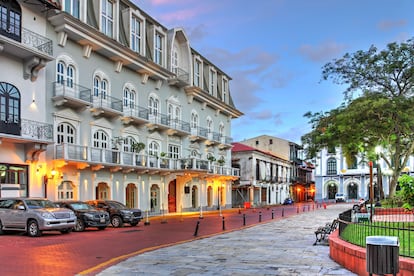
In the Old Town, there are accommodations and tables for all types of budgets. Among the hotels and restaurants to highlight, one of the latest and most notable establishments is recommended: La Compañía, a tasteful hotel, converted from a Jesuit convent. Several architectural and archeological elements from different periods remain, while the residential wings and themed restaurants relate to the esthetics and cuisines of the different countries that had a presence in or historical influence on Panama (Spain, France and the United States). Even if you’re not going to sleep or eat, it’s advisable to visit.
Another excellent and brand new hotel is the Sofitel Legend Casco Viejo, located in a privileged location on the edge of the Pacific, with unbeatable views of the Panama City skyline. Good restaurants to enjoy Panamanian cuisine and have a drink in the Old Town are Casablanca and Lo que hay (“whatever there is”).
Let’s get back to Panama Viejo, the name given today to the archeological site that preserves the ruins of the original city of Panama, which was founded by Pedrarias Dávila in 1519 and destroyed by the English pirate Henry Morgan. In its heyday, it was the place where gold from Peru arrived. After crossing the isthmus and changing oceans, it was sent to Spain. Among the ruins, there’s an old tower, which used to be the church-cathedral. This large area, occupied by the remains of Old Panama, is undoubtedly worth a visit.
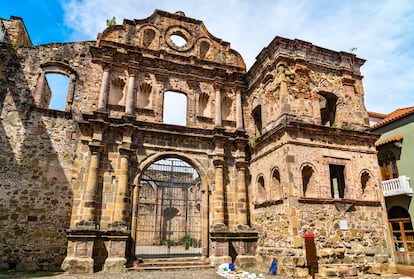
Colonial fortresses and Caribbean beaches
“In a single day, I counted 200 mules loaded with silver and gold… piles of silver ingots piled up like stones in the streets. In a few days, everything was loaded into a fleet [made up] of eight galleons and 10 merchant ships.” This is how, in 1637, the English clergyman Thomas Gage described the incredible spectacle that he witnessed in the streets of the port town of Portobelo. Years before, Bartolomé de las Casas, the Dominican friar who chronicled the colonization of the West Indies, had written something similar, referring to the enormous movement of precious metals that took place in the port of Nombre de Dios, located in contemporary Panama: “From there, it embarked for Spain [after arriving] from Peru… enormous amount of gold, never seen, nor even dreamed of.”
For almost three centuries, the two trails that linked Old Panama along the Pacific with the Caribbean — Camino Real and the Camino de Cruces — were, in the colonial era, the routes along which the most wealth traveled in the world. Created by the Spanish monarchy, a naval force was charged with protecting the enormous quantities of gold, silver and precious stones that, coming from the Viceroyalty of Peru, regularly arrived in Old Panama. From there, the immense treasures continued their journey, until reaching the port of Nombre de Dios and then Portobelo, on the Atlantic coast. From here, the West Indies Fleet finally delivered the precious shipments to Spain.
To protect the circulation of so much treasure from English piracy, Spain built different fortifications at key points along the trade routes that crossed the isthmus. One of them was the San Lorenzo Fort, located on top of a high cliff overlooking the mouth of the Chagres River in the Caribbean. The stronghold — ordered to be built by Philip II of Spain — was designed by the expert engineer Bautista Antonelli. Over the centuries, the place suffered different attacks by privateers and British sailors (Francis Drake, in 1596; Henry Morgan, in 1671; Edward Vernon, in 1740). An obligatory visit allows travelers to enjoy spectacular views of the jungle, the river and the ocean, while witnessing a magnificent example of military defensive architecture.
From Old Panama on the Pacific, to the Atlantic or Caribbean ports, the two aforementioned routes could be followed in colonial times: one by land (Camino Real) and the other by land, river and sea (Camino de Cruces). Both reached Nombre de Dios and Portobelo. As the port town of Portobelo had better conditions than Nombre de Dios to organize the defense of the enclave, with the passage of time, all commercial activity eventually was concentrated there. For this reason, Portobelo preserves remains of several fortifications that protected its bay and its natural port, the most important being the San Jerónimo Fort, the San Fernando Fort and the Santiago Fort.
All these defensive enclosures, unlike that of San Lorenzo, are still awaiting their well-deserved restoration. However, at sunset, its old walls made of coral stone and the many cannons scattered along its walls make for an evocative experience. The fortifications of Portobelo have also been declared a UNESCO World Heritage Site since 1980.
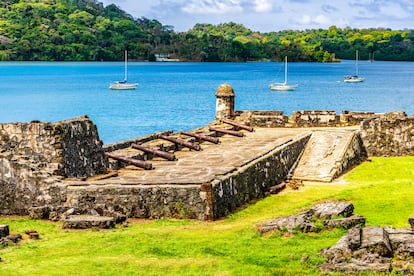
One Renaissance building that has recently been restored is the splendid and historic Royal Customs headquarters, built in 1630. From here, the colonial transoceanic trade was administered. The Church of San Felipe, which houses the famous and venerated Black Christ of Portobelo, is another obligatory stop. Wandering around the town, one can imagine the frenetic and chaotic hustle and bustle that the city experienced when the Fleet of the West Indies arrived with products from the Peninsula. If you stop for a drink in this town, located about two hours by car from Panama City, a good place to eat is El Castillo, which has a magnificent patio facing the sea. Casa Congo is another establishment that also hits the spot.
The surroundings of Portobelo offer plenty of opportunities to go hiking in the nearby natural parks, or to enjoy the clear waters and Caribbean coves spread throughout the area’s coastline. A good plan could be to travel by boat along the coast towards Isla Grande, where you’ll spend the night at the Candy Rose Hotel, or at the Bananas Village. But before that, and throughout the day, you should try to sail through the mangroves, take a dip, sunbathe, or go snorkeling in one of the many coves or water spots that are found along the route.
It’s a good idea to eat in the small coastal town of Cacique. There, you can choose between several places. Trying shrimp and fried fish with plantains at Margarita’s small Caribbean restaurant won’t disappoint. She does it all with love: she cooks and she serves the four tables herself.

Tropical jungles and lost paradise
Getting to Playa Muerto isn’t easy or quick. First, from Panama City, you have to drive five or six hours on bumpy roads. Then, from Puerto Quimba, three more hours by speedboat along the Iglesia River, along the Pacific coast, until you finally reach the northeastern end of the Darién Biosphere Reserve, a national park and another UNESCO World Heritage Site.
Playa Muerto is a remote place that can only be accessed by sea. But when you reach it, you’ll find a small, lost paradise that’s almost surreal. The town, made up of members of the Indigenous Emberá ethnic group, leads a way of life that’s in deep harmony with nature. It seems like it’s from another time. A naturally conservationist community, the residents are careful to preserve their cultural identity, their traditions and their environment. It’s not a coincidence that the word Emberá means “good man.”
Secluded from the world, on the edge of the jungle, near a wild, idyllic beach full of palm trees, 200 members of the community live in houses built on stilts. They fish for protein and grow everything they need — bananas, cassava, rice, corn, coffee — at the mouth of the Jesús River, or in the South Sea.
The Emberá have their own language. They adorn themselves and paint their bodies colorfully. And, while they’re no strangers to certain advances and comforts of modern society, they persevere in keeping their ancestral rites and customs alive. Women, for example, usually go about topless, cooking directly over fire and serving food and drinks in bowls made from gourd (a type of large fruit similar to the coconut).
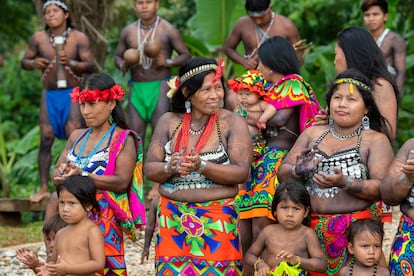
Playa Muerto is a perfect destination for travelers eager to experience beautifully-preserved nature, while sleeping, eating and living in the community that the Emberá have long maintained. Nowadays, the few visitors who venture here are either passengers on small cruise ships who reach the beach by canoe and spend time with the Indigenous community, or small groups of tourists that enter the jungle to explore the region, taking all kinds of treks to bird-watch or locate the tracks of jaguars and pumas. At certain times of the year, you can also see whales in the ocean, or see several species of turtles laying eggs.
Only a handful of local organizations offer these activities. Among the most professional and recommended are Ecotour Darién and Dynamo Travel. Their respective managers, Erasmo de León and Gustavo Zevallos, are very knowledgeable about the flora and fauna of the practically virgin Darién ecosystem. They, along with the Panama Tourism Authority, are also helping the Indigenous population of Playa Muerto to maintain their culture by providing them with supplementary resources and creating appropriate opportunities, so that their community can enjoy sustainable development.
And, of course, the Canal
According to Jerónimo Welchs, an expert guide for Aventuras 2000, the main Panamanian tour operator, no one who visits Panama should leave the country without visiting the Canal. It was Emperor Charles V of Spain who, in 1534, was the first to study the possibility of building a canal in Panama that would link the Atlantic with the Pacific through the narrowest part (50 miles) of the Panamanian isthmus. But the project had to wait until 1880 for the French engineer Ferdinand de Lesseps to try and bring it to completion.
After more than eight years and 20,000 dead workers, the project was suspended, until it was resumed by the United States, which completed the canal in 1914. Since then, the Panama Canal has continued to operate normally. In 2006, to allow larger ships to cross, it was decided that what practically amounted to a second canal had to be created, with wider, longer and deeper locks. This was inaugurated in 2016. Today, the Panama Canal continues to be one of the main sources of income for the country (6.8% of GDP), while representing 6% of the world’s commercial transportation.
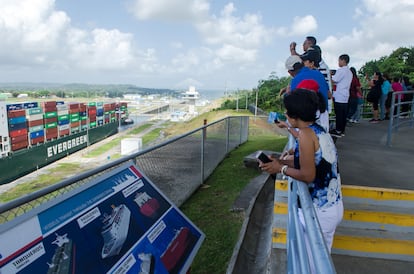
This impressive work of modern engineering — as well as the maneuvers of large cargo ships making their way from Gatún Lake to the Atlantic Ocean — can be seen from the Agua Clara Visitor Center, near the city of Colón. You can also watch a film that offers all kinds of details about the Canal: its history, the functions of the artificial Gatún Lake, the biodiversity of the environment that the project is built through, the operation of the locks, the number and types of boats that cross per day and the cost of cargo. The closer you get to Panama City, it’s also possible to learn everything about the Canal from the Pacific side at the Miraflores Visitor Center.
The country’s tourism slogan tries to convey, among other things, that, in Panama, there are many things to experience and discover: “We dare you to live for more.”
Sign up for our weekly newsletter to get more English-language news coverage from EL PAÍS USA Edition
Tu suscripción se está usando en otro dispositivo
¿Quieres añadir otro usuario a tu suscripción?
Si continúas leyendo en este dispositivo, no se podrá leer en el otro.
FlechaTu suscripción se está usando en otro dispositivo y solo puedes acceder a EL PAÍS desde un dispositivo a la vez.
Si quieres compartir tu cuenta, cambia tu suscripción a la modalidad Premium, así podrás añadir otro usuario. Cada uno accederá con su propia cuenta de email, lo que os permitirá personalizar vuestra experiencia en EL PAÍS.
¿Tienes una suscripción de empresa? Accede aquí para contratar más cuentas.
En el caso de no saber quién está usando tu cuenta, te recomendamos cambiar tu contraseña aquí.
Si decides continuar compartiendo tu cuenta, este mensaje se mostrará en tu dispositivo y en el de la otra persona que está usando tu cuenta de forma indefinida, afectando a tu experiencia de lectura. Puedes consultar aquí los términos y condiciones de la suscripción digital.
More information
Archived In
Últimas noticias
There is as much life left to discover on planet Earth as that which is already known
Dozens presumed dead, around 100 injured in fire at Swiss Alps bar during New Year’s celebration
Is porn for women different from conventional porn? We spoke to those who make it
Cartagena de Indias is sinking: What can the city do to mitigate it?
Most viewed
- Sinaloa Cartel war is taking its toll on Los Chapitos
- Reinhard Genzel, Nobel laureate in physics: ‘One-minute videos will never give you the truth’
- Oona Chaplin: ‘I told James Cameron that I was living in a treehouse and starting a permaculture project with a friend’
- David King, chemist: ‘There are scientists studying how to cool the planet; nobody should stop these experiments from happening’
- Why the price of coffee has skyrocketed: from Brazilian plantations to specialty coffee houses
